TRIFED Showcases India's Tribal Craftsmanship at G20 Summit
For Prelims: Longpi Pottery, Gond Paintings, Meenakari Crafts, Gujarat Hangings, TRIFED
For Mains: Role of TRIFED in empowering tribal communities, Socio-economic Development of Tribal Communities
Source: PIB
Why in News?
The recent 18th G20 Summit witnessed a captivating display of India's rich tribal heritage and craftsmanship, curated and presented by the Tribal Cooperative Marketing Development Federation of India(TRIFED), Ministry of Tribal Affairs.
What Artifacts and Products did TRIFED Display at the G20 Summit?
| Artifacts/Products |
Description |
|
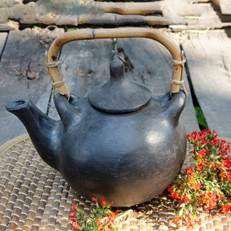
Longpi Pottery:
|
- Originating from the village of Longpi in Manipur, the Tangkhul Naga tribes practise this unique pottery style.
- Longpi pottery stands out as it doesn't rely on the potter's wheel; everything is hand-shaped or moulded.
- The distinct grey-black cooking pots, sturdy kettles, and charming bowls are Longpi's trademarks, but new design elements are being introduced.
|
|
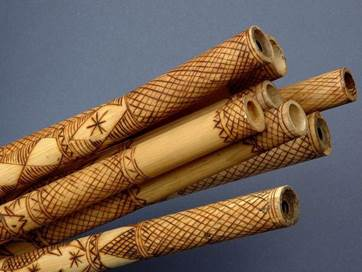
Chhattisgarh Wind Flutes:
|
- 'Sulur' bamboo wind flute is a unique musical creation curated by the Gond Tribe of Bastar in Chhattisgarh.
- It produces melodies through a simple one-handed twirl and has fish emblems, geometric lines, and triangles etched on its surface.
- The 'Sulur' serves utilitarian purposes, helping tribal men ward off animals and guide cattle through jungles.
- It showcases the Gond Tribe's ingenious craftsmanship, which is a harmonious blend of artistry and functionality.
|
|
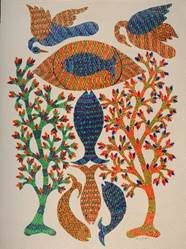
Gond Paintings:
|
- Gond paintings reflect their deep connection to nature and tradition.
- They start with dots, calculating image volume, which they then connect to form outer shapes filled with vibrant colours.
- These artworks are deeply influenced by their social environment and they stand as a testament to the tribe's artistic ingenuity.
|
|
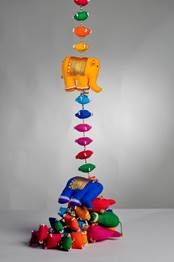
Gujarat Hangings:
|
- Curated by the Bhil & Patelia Tribe in Dahod, Gujarat, these wall hangings are rooted in ancient Gujarat art.
- Initially, the hangings were dolls and cradle birds made of cotton cloth and recycled materials.
- The hangings now include mirror work, zari, stones, and beads, blending tradition with contemporary fashion.
|
|
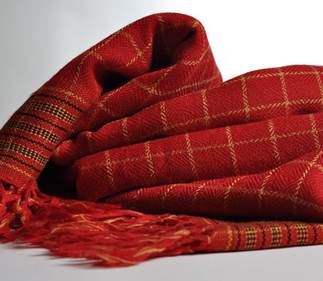
Sheep Wool Stoles:
|
- Crafted by the Bodh, Bhutia, and Gujjar Bakarwal tribes from Himachal Pradesh/Jammu & Kashmir.
- They use pure sheep wool to make various clothing, including jackets, shawls, and stoles.
- Originally featuring monochromatic schemes of white, black, and grey, Tribal craftsmanship is undergoing a transformation with dual-coloured designs becoming popular.
|
|
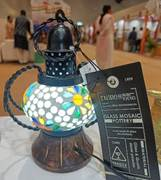
Rajasthan Artistry:
|
- Mosaic Lamps:
- Captures the mosaic art style and is crafted into lampshades and candle holders. When illuminated, they unleash a kaleidoscope of colours, adding vibrancy to any space.
|
|
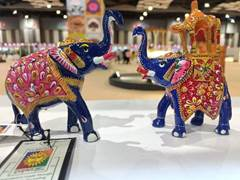
Ambabari Metalwork:
|
- It is curated by the Meena Tribe and also embraces enamelling, a meticulous process that elevates metal decoration.
- Today, it extends beyond gold to metals like silver and copper.
|
| Meenakari Crafts: |
- Meenakari crafts involve decorating metal surfaces with vibrant minerals, a tradition demanding exceptional skill, introduced by the Mughals.
- This tradition demands exceptional skills as delicate designs are etched onto metal, creating grooves for colours to nestle in.
|
Tribal Cooperative Marketing Development Federation of India(TRIFED):
- TRIFED came into existence in 1987. It is a national-level apex organisation functioning under the administrative control of the Ministry of Tribal Affairs.
- The objective of TRIFED is the socio-economic development of tribal people in the country by way of marketing development of the tribal products such as metal craft, tribal textiles, pottery, tribal paintings and pottery on which the tribals depend heavily for a major portion of their income.
- TRIFED acts as a facilitator and service provider for tribes to sell their product.
- The approach by TRIFED aims to empower tribal people with knowledge, tools and a pool of information so that they can undertake their operations in a more systematic and scientific manner.
- It also involves capacity building of the tribal people through sensitization, formation of Self Help Groups (SHGs) and imparting training to them for undertaking a particular activity.
- TRIFED has its Head Office located in New Delhi and has a network of 13 Regional Offices located at various places in the country.
UPSC Civil Services Examination Previous Year Question (PYQ)
Mains
Q.1 Safeguarding the Indian Art Heritage is the need of the moment. Discuss. (2018)












-min.jpg)